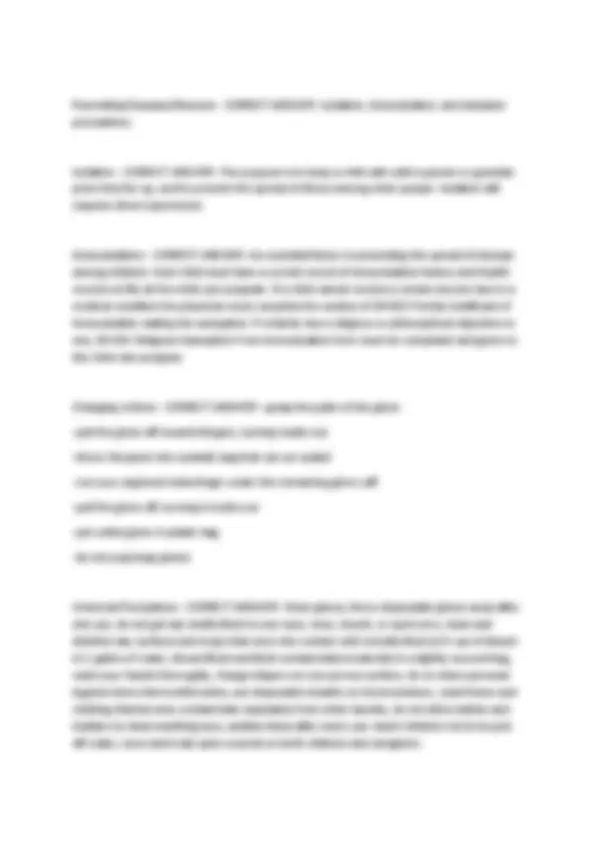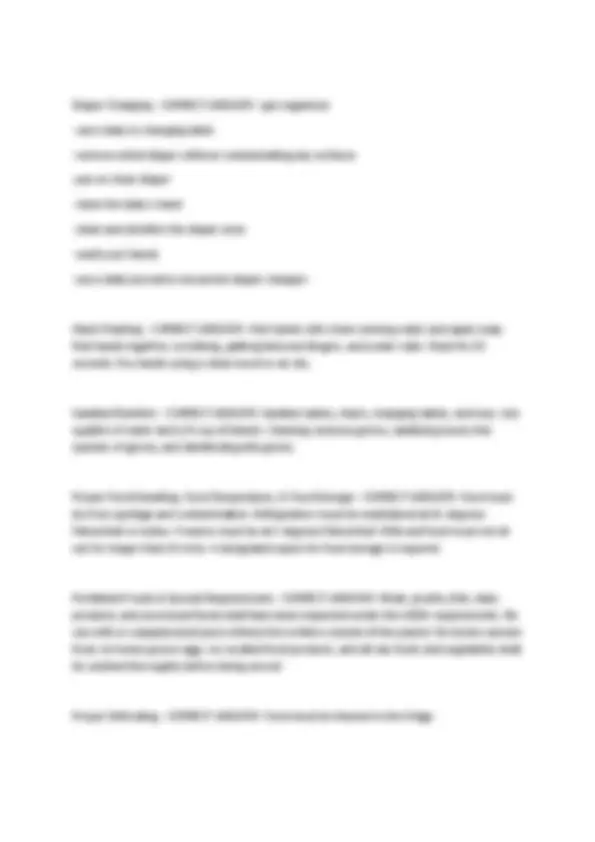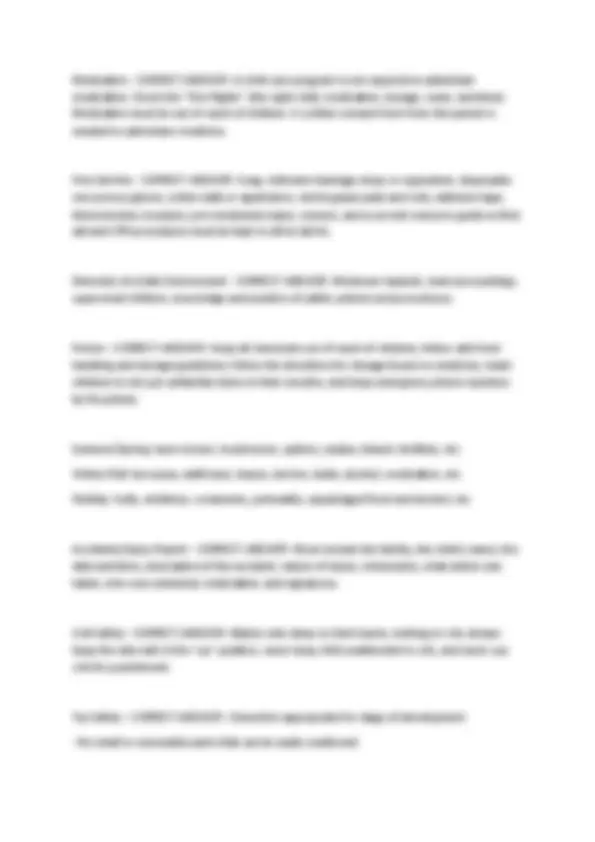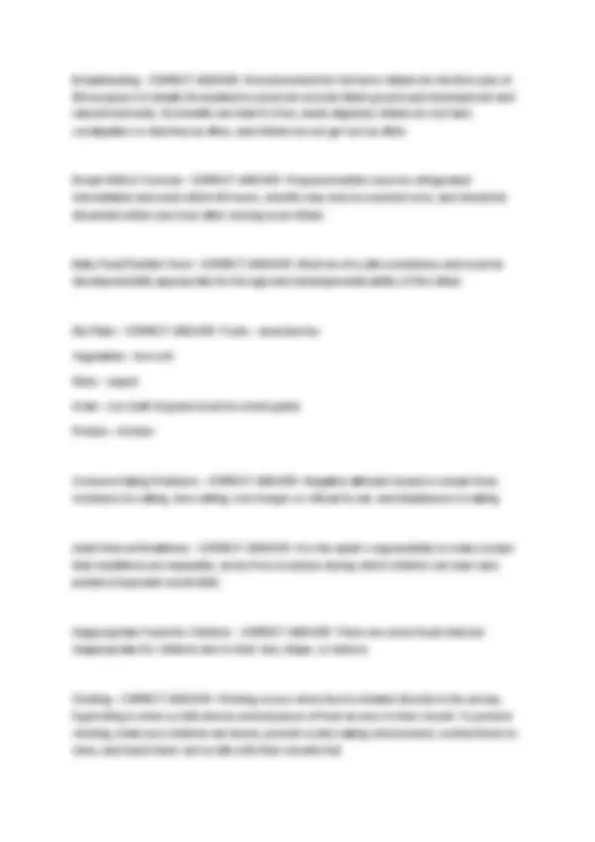







Study with the several resources on Docsity

Earn points by helping other students or get them with a premium plan


Prepare for your exams
Study with the several resources on Docsity

Earn points to download
Earn points by helping other students or get them with a premium plan
Community
Ask the community for help and clear up your study doubts
Discover the best universities in your country according to Docsity users
Free resources
Download our free guides on studying techniques, anxiety management strategies, and thesis advice from Docsity tutors
DCF - HEALTH, SAFETY, & NUTRITION FLASH CARDS Healthy Environment & Written Policies - CORRECT ANSWER -Clean work and play areas, proper hygiene practices, implementation and routine practice of a written health policy. Policies are written for awareness and consistency. Healthy Child Characteristics - CORRECT ANSWER -Appetite - will eat a variety of food and happy after eating Appearance - no rashes, growing, has clear bright eyes, and well-developed muscles Activity - involved, interacting, has energy, and alert Daily Health Check - CORRECT ANSWER -A good way of preventing, identifying, and controlling illness in a child care environment. Behavior - general mood, unusual behavior, activity level, and breathing difficulties Physical - discharge (from nose, eyes, and ears) Also check for a fever of 100.4 and vomiting. Dehydration - CORRECT ANSWER -Symptoms: dry to very dry mouth, little or no tears when crying, less active, very fussy, ey
Typology: Exams
1 / 9

This page cannot be seen from the preview
Don't miss anything!






Healthy Environment & Written Policies - CORRECT ANSWER - Clean work and play areas, proper hygiene practices, implementation and routine practice of a written health policy. Policies are written for awareness and consistency. Healthy Child Characteristics - CORRECT ANSWER - Appetite - will eat a variety of food and happy after eating Appearance - no rashes, growing, has clear bright eyes, and well-developed muscles Activity - involved, interacting, has energy, and alert Daily Health Check - CORRECT ANSWER - A good way of preventing, identifying, and controlling illness in a child care environment. Behavior - general mood, unusual behavior, activity level, and breathing difficulties Physical - discharge (from nose, eyes, and ears) Also check for a fever of 100.4 and vomiting. Dehydration - CORRECT ANSWER - Symptoms: dry to very dry mouth, little or no tears when crying, less active, very fussy, eyes are sunken, hands and feet are cool and blotchy, pulse may seem week and fast, infants will wet less than 6 diapers a day; a child will make fewer trips to the restroom than they normally do Treatment: give water, take and record child's temperature, communicate with parents Heat Exhaustion - CORRECT ANSWER - Symptoms: pale and clammy skin, feeling sick, dizzy, and/or faint, rapid pulse rate and breathing, headache or muscle cramps Treatment: notify parents immediately, lay child down in a cool place, elevate feet, loosen tight clothing, give fluids (water)
Heat Stroke - CORRECT ANSWER - Symptoms: skin flushed, hot and dry, elevated temperature, skin hot to the touch, strong and rapid pulse, confusion or loss of consciousness Treatment: immediate medical attention - call 911, notify parents, remove clothing - wrap in a cold wet sheet or sponge with cold tepid water, fan child, when temp lowers to 101 F, place child on their back and continue to fan, cover with dry sheet Communicable Disease - CORRECT ANSWER - A disease that can be spread from one person to another. Germs - CORRECT ANSWER - Bacteria: can cause strep throat, impetigo, pinkeye, and some pneumonia, treated with antibiotics Virus: can cause chicken pox, measles, German measles, mumps, prevented with vaccines Fungi: can cause athlete's foot and ringworm, treated with medication when fungi favorable conditions are removed Parasites: pin worms, roundworms, and lice, treated with medication 4 Ways Diseases are Transmitted - CORRECT ANSWER - Respiratory, fecal/oral, direct contact, blood borne. Serious Communicable Diseases - CORRECT ANSWER - Haemophilus Influenzae B (Hib): infection that can lead to meningitis, pneumonia; caused by a germ that spreads through coughing and sneezing Hepatitis B/C: B- Infection to the liver, vaccine avail, most commonly spread from mother to infant at birth; C-Disease of the liver, no vaccine Human Immunodeficiency Virus (HIV): virus that causes an increasing loss of immune function that results in the body becoming unable to fight off infections; less commonly spread by infected mothers who breastfeed their infants; and exposure of open wounds or mucus membranes to contaminated blood Common Childhood Illnesses - CORRECT ANSWER - Chicken Pox, common cold, Conjunctivitis, Influenza, sore throat, diarrhea, allergies, Giardiasis, RSV (Respiratory Syncytial Virus), and lice.
Diaper Changing - CORRECT ANSWER --get organized
Medication - CORRECT ANSWER - A child care program is not required to administer medication. Check the "Five Rights" (the right child, medication, dosage, route, and time). Medication must be out of reach of children. A written consent form from the parent is needed to administer medicine. First Aid Kits - CORRECT ANSWER - Soap, Adhesive bandage strips or equivalent, disposable non-porous gloves, cotton balls or applicators, sterile gauze pads and rolls, adhesive tape, thermometer, tweezers, pre-moistened wipes, scissors, and a current resource guide on first aid and CPR procedures must be kept in a first aid kit. Elements of a Safe Environment - CORRECT ANSWER - Minimum hazards, neat surroundings, supervised children, knowledge and practice of safety policies and procedures. Poison - CORRECT ANSWER - Keep all chemicals out of reach of children, follow safe food handling and storage guidelines, follow the directions for dosage found on medicine, teach children to not put unfamiliar items in their mouths, and keep emergency phone numbers by the phone. Summer/Spring: lawn mower, mushrooms, spiders, snakes, bleach, fertilizer, etc. Winter/Fall: kerosene, antifreeze, leaves, berries, bulbs, alcohol, medication, etc. Holiday: holly, mistletoe, ornaments, poinsettia, unpackaged food and alcohol, etc. Accidents/Injury Report - CORRECT ANSWER - Must include the facility, the child's name, the date and time, description of the accident, nature of injury, witness(es), what action was taken, who was contacted, medication, and signatures. Crib Safety - CORRECT ANSWER - Babies only sleep on their backs, nothing in crib, always keep the side rails in the "up" position, never keep child unattended in crib, and never use crib for punishment. Toy Safety - CORRECT ANSWER --Should be appropriate for stage of development
Evacuation Drill - CORRECT ANSWER - Describe how to initiate the procedure, designate where staff will take children, follow established evacuation routes, and designate a specific staff member to call 9- 1 - 1. Car Seats - CORRECT ANSWER --the location
Breastfeeding - CORRECT ANSWER - Recommended for full-term infants for the first year of life because it is ideally formulated to promote normal infant growth and development and natural immunity. Its benefits are that it's free, easily digested, infants do not have constipation or diarrhea as often, and infants do not get sick as often. Breast Milk & Formula - CORRECT ANSWER - Prepared bottles must be refrigerated immediately and used within 48 hours, a bottle may only be warmed once, and should be discarded within one hour after serving to an infant. Baby Food/Toddler Food - CORRECT ANSWER - Must be of a safe consistency and must be developmentally appropriate for the age and developmental ability of the infant. My Plate - CORRECT ANSWER - Fruits - strawberries Vegetables - broccoli Dairy - yogurt Grain - rice (half of grains must be whole grain) Protein - chicken Common Eating Problems - CORRECT ANSWER - Negative attitude toward a certain food, resistance to eating, slow eating, non-hunger or refusal to eat, and displeasure in eating. Adult Role at Mealtimes - CORRECT ANSWER - It is the adult's responsibility to make certain that mealtimes are enjoyable, stress-free occasions during which children can learn and practice important social skills. Inappropriate Foods for Children - CORRECT ANSWER - There are some foods that are inappropriate for children due to their size, shape, or texture. Choking - CORRECT ANSWER - Choking occurs when food is inhaled directly in the airway. Squirreling is when a child shoves several pieces of food at once in their mouth. To prevent choking, make sure children eat slowly, provide a calm eating environment, remind them to chew, and teach them not to talk with their mouths full.